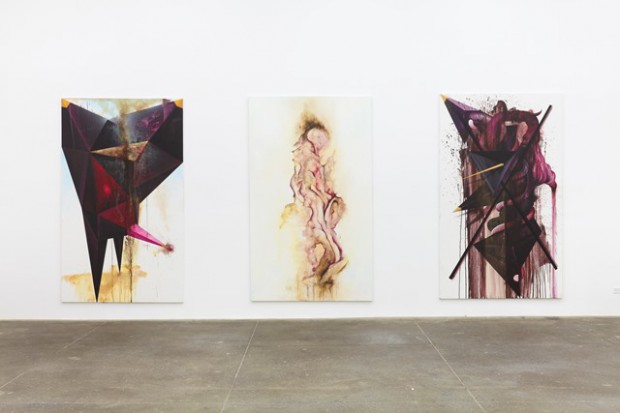Painter Piotr Janas’s exhibition Minotaurs at Bortolami is nothing if not commanding. The unadorned exhibition space is dominated by nine simultaneously stark and organic large-scale paintings of geometry and viscera. Seeing man’s guts strung out in these form-scapes makes the message very clear: Never forget how ugly your humanity is; never pretend it’s noble.
But how clear is too clear? The exhibition operates on the principle that it needs to drill the message home. Assume your audience has no capacity for retention. Squeeze comprehension out of these ignoble humans through iteration. However condescending, I actually thought that the persistence of the message successfully induced the state of abjection that the paintings were trying to convey. But let’s just stick a pin in my appreciation for now, because the heavy-handedness is hard to ignore.
To illustrate my point, I’ve made a list, numbered for your convenience, of the five techniques Janas uses to drive the point home:
- In many of the works, there is a starburst at the tip of an organ shape. Even starbursts do not make the shapes seem more valuable, showing just how incapable the forms are of such value.
- The organic human shapes all appear very malleable; pulled and twisted. In most of the works, rigid lines and geometrical shapes remind us of our human flimsiness.
- The inorganic parts of these paintings are rendered in lighter, fluid strokes. The blood and excrement are rendered in thick, crusty paint. Because humanity is made of ugliness. Get it?
- Most of the organs are ambiguous, embedded in blobs of other organ-like matter. Because these paintings are not about highlighting and glorifying by context the parts of men. No, these paintings are about the ugly mass that is humanity.
- This very redundancy makes it impossible for us to feel clever when we figure out what’s happening in the paintings. It’s much too obvious. Because, clearly, humans are not clever. We’re just shit and testicles.
So, now that I’ve seen nine of these giant paintings, I get I’m nothing more than human. I’ve bought that the paintings are about me—they’re too large and persistent for that not to be clear. But what I didn’t immediately get was that I’m not just nothing more than human; I’m nothing more than a man. I was not a woman while I was viewing these paintings, because in this world women don’t exist. All the symbols of humanity were either gender neutral or male. I was bombarded by scrota and testicles, and, in one exceptional instance, a scrotum in a necktie. Was that just to reiterate the masculinity? (Because, as we know, each point must be repeated time and again.)
Since I didn’t mind shelving my vagina femininity while I observed, I actually found that the total exclusion of females from the world of the paintings enriched my experience. Forcing suspension of my own reality allowed the art to take the space in my mind where my identity would usually be distracting me. In fact, it was the most (perhaps the only) nuanced part of my experience. However, if you are female and value your identity a tad more than I do, the female exclusion might feel more like an oversight that alienates half the potential audience than the enhancement it was for me.
While it may be a rather strange prerequisite, the exhibition is best when you effectually set aside your existence for the duration of the show. If you intentionally forget to take offense at the belittling of your intelligence, or the total exclusion of your gender, the show works. Abjection is a powerful, if not the most difficult to express, experience, and Minotaurs takes you there. The show is conditionally effective, though well short of excellent.




Comments on this entry are closed.